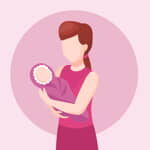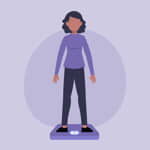Getting started
Using Nabta
The Nabta app currently helps by assessing immediate symptoms through tracking your health data. However, Aya may ask you some questions about your medical history if she is prompted to by your logged data.
Aya is a health-assistant built by top scientists, doctors and software engineers. Aya is excellent at recommending specific devices and tests that can be used to determine if you have symptoms for specific diseases. However, in order to receive a medical diagnosis, Aya will always recommend that you speak to a qualified medical professional.
Our health-assistant, Aya, will recommend the app mode most relevant to your health goal(s) – track your cycle, help you to conceive, monitor your pregnancy, understand and prepare for menopause, or to generally get fit and healthy.
You will be able to switch between modes by selecting a different mode in the app menu (bottom right-hand icon). Feel free to check out each mode and decide which one suits you best!
We recommend using the Nabta app as regularly as possible. You should aim to add information about your health in the form of mode-specific logs on a daily basis, or, as often as you can. Why? This will give us the most informed picture of you, so we can provide you with personalised advice, support and recommendations.
Welcome to Nabta! We’re empowering women to blossom at all ages by personalising women’s health journeys at every age and every stage.
Manage your health in one place with the support of your AI-powered personal health assistant, Aya. Aya will help determine which one of four modes you should be in to achieve your goals:
- Get Fit & Healthy
- Track my Cycle
- Monitor My Pregnancy
- Prepare For Menopause.
You’ll be able to access mode-specific features, support, integrated devices and tests, all housed within the Nabta app – everything you need to live your healthiest life.
After your initial conversation with Aya, you should log as much information about your health as you can, in order for us to give you the best advice and support. Based on the information you log, your interactions with Aya and your health goal, the app may recommend specific devices, tools and specialist support that you need for your individual health journey. If you have any questions, don’t hesitate to send us a message, we’re always here to help!
About Nabta
Currently, Aya is only a text-based health assistant!
Meet Aya, our AI-powered health assistant chatbot. Aya speaks both English and Arabic and interacts with users following a natural conversation they may have with a healthcare practitioner. Aya aims to provide users with actionable help and support, building care plans personalised to them. Aya is always learning, from the information banks we provide her and from the interactions of our users, to give better insights to users, and ultimately, help them to achieve their goals.
Nabta Health is a team of healthcare professionals, scientists, and technologists who believe that women’s healthcare today is compromised. We are reshaping women’s healthcare in the MENA region.
We empower every woman to take control of her personal health journey, from everyday well-being to the uniquely female experiences of fertility, pregnancy, and menopause. Our app is the gateway to discreet, personalised and helpful healthcare, cutting the time taken for diagnosis and treatment of any woman’s health issues.
Nabta is an app to support women through key stages of their lives – puberty, fertility, pregnancy, menopause – and overall health and wellbeing. There are four modes in the app and from your interaction with Aya, our AI-powered health assistant, you will be placed in the most suitable mode to achieve your goals. You can change your mode at any time by clicking on the settings menu.
The four modes of the Nabta app are:
1 – Get Fit and Healthy:
Making your health, fitness and wellbeing goals achievable all in one place. Everything you need to live your healthiest life.
Key features include: workouts for all abilities, weight management, and integrations with wearable devices.
2 – Track My Cycle:
We’ll help you to conceive or avoid becoming pregnant. Access wellness tests and fertility devices to optimise your health and give you the best chance of pregnancy, if, and when, that’s what your goal is.
Key features include: an in-built cycle tracker, an integrated FDA-approved, CE certified medical device that detects ovulation with 99% accuracy, and integrated at-home blood tests to check your current health status via Nabta Care (COMING SOON).
3 – Monitor My Pregnancy:
Discover and understand your pregnancy. See your baby’s progress with our augmented reality foetus encounter. Log all of your pregnancy symptoms, and receive the best advice & support, you’ll have everything you need to prepare for your new arrival.
Key features include: an augmented reality foetus encounter, a birth plan builder, and pregnancy workouts.
4 – Prepare for Menopause:
For you to take control of menopause, not the other way around. Log your symptoms, check your vitamin & mineral levels, and discover the best advice to support you through this transformative period. Everything you need to look and feel like you.
Key features include: a symptom tracker for perimenopause, hundreds of tips and advice, and integrated at-home blood tests to check your health status and hormone levels via Nabta Care (COMING SOON).
My Nabta Account
Nabta is available in English and Arabic.
You can easily edit your personal information via the settings area in the app’s menu. To edit previously logged health data, you can select the date of the log you wish to change in the calendar, and update the log.
To add further health information, press the Nabta logo at the bottom of the screen in the center of the menu and select the relevant log you wish to add the information too.
It’s very simple to reset your password for the Nabta app. Either you can reset your password when you’re logging into the app or from the settings area in the app’s menu.
Security and Personal Data
Nabta does not use your data for research purposes unless you explicitly give us consent to do so. We may contact you separately about opportunities to participate in women’s health research projects.
The only individuals who have access to your personal health data are Nabta employees. If Nabta recommends that you should see a healthcare specialist, you can select to share your data with your healthcare provider.
Nabta does not share your data with anyone unless you explicitly tell us to do so. You can read more about how we use data in our Privacy Policy here.
Shop
tabby is a better way to pay.
Split into 4 interest-free payments
Buy now and split the cost into 4 equal payments. Your debit or credit card will be billed every month. No interest and no fees.
Pay in 14 days
Get your order first and make your payment in full 14 days with any card after your purchase is shipped. No upfront payments, no interest, and no fees.
Safe credit limits
To keep shopping safe, spending limits are based on a number of factors including the type of products you’re buying, the store you’re buying from and your history with tabby.
Zero cost
tabby is free to use! tabby does not charge interest or fees for any payments that are made on time.
Visit tabby’s help center to find out more.
We’ve partnered with tabby to bring you a better way to shop for essential women’s health and wellness products and services. tabby lets you shop now and pay after delivery or in installments with your debit or credit card. No interest. No hidden fees.
Here’s how it works
- Step 1: Select tabby at checkout
- Step 2: Create an account and link any debit or credit card
- Step 3: Complete checkout and tabby will remind you when it’s time to pay
Here’s who can use it
Any resident of the UAE and KSA that’s over the age of 18 can use tabby.
About tabby
tabby empowers you with the flexibility and freedom to choose how and when to pay for the things you love. You can buy now and pay after delivery or in installments without interest or fees, both online and in-store.
tabby is regulated by the Saudi Central Bank, Shari’ah-compliant, and PCI DSS certified. Learn more about tabby.
For each purchase over 500 AED, Nabta Health pledges to buy and donate a month’s worth of organic, biodegradable sanitary products to women in the region.
This means each time you use the Nabta Women’s Health Shop to source products or services that help your wellness journey, you will also be helping another woman as she goes through her journey.
To fulfill #ShopForGood, we are delighted to have partnered with LiZZOM, a fantastic UAE women’s products start-up, who allow you to make choices that make you feel good from the inside out.
Persisting taboos and stigma continue to undermine the way we talk about menstruation in the MENA region. As a result, millions of women and girls are kept from reaching their full potential. Either through lack of education, lack of resources or lack of understanding, not all women are able to access sustainable, safe personal hygiene products that make them feel good.
All girls and women should feel empowered to manage their periods hygienically, with confidence and without shame. Through the Nabta Women’s Health Shop, we are committed to donating hygiene products to women in need across the MENA region, beginning in the UAE.
As a leading provider of women’s health support in the region, we are passionate about making a real difference to women’s lives across MENA. We believe companies in our position have purpose that goes beyond profit; we engage in activities that promote social good.
The ethos of the Nabta Women’s Health Shop is firmly rooted in socially conscious, sustainable, and evidence-based products and services. #ShopForGood allows us to take that one step further tangible and accountable action.
Health
Intermittent fasting is classed as a diet, but is, more accurately, an eating pattern, comprising of periods of fasting and periods of eating ad libitum (“at one’s pleasure”).
There are three main fasting methods:
- 16/8 method (time-restricted feeding). People who follow this approach fast for 16 hours and eat for 8 hours. In fact, whilst 16 hours is suggested, those who do time-restricted feeding fast for anything from 12 to 21 hours. It is the most popular form of intermittent fasting.
- Eat-stop-eat (alternate day fasting). This concept involves fasting for 24 hour periods, once or twice a week. Although participants can eat what they like on the non-fast days, studies suggest that most people naturally reduce their calorie intake on the days in between.
- 5:2 diet (modified fasting). Those who adopt this approach reduce their energy intake by 70-75% for two non-consecutive days each week. On the fasting days they limit themselves to between 500 and 600 calories, eating ad libitum on the remaining days.
Following weight loss, the number of fat deposits (energy stores) in the body reduce. Hormones, such as leptin, which is stored in adipose tissue and is responsible for modulating whether or not we feel hungry, feed back to the brain that these fat stores have fallen to a critical level.
The brain initiates a series of responses to overcome this. Crucially the brain tells the muscle tissues to become more efficient and burn fewer calories. However, as part of the same feedback mechanism, the body actually requires an increased number of calories to feel satiated after eating. This is because the areas of the brain involved in seeing food as a reward become more active, and those involved in resisting eating become less active. In other words, we are less able to restrain ourselves from over-eating.
Put simply, when we have lost a significant amount of weight we feel hungrier, which is then reflected in larger meal sizes and the consumption of more calories. As the rate of our energy expenditure does not increase proportionally, the net result is an excess of calories, which can all too easily translate into unwanted weight gain.
BMI uses height and weight to provide an estimate of a person’s body fat:
BMI = weight in KG / height in metres2
Doctors classify people according to their BMI; for most adults (male and female):
- BMI < 16.5 – severely underweight
- BMI < 18.5 – underweight
- BMI 18.6-24.9 – normal weight
- BMI ≽ 25 – overweight
- BMI ≽ 30 – obese. BMI 30-34.9 – obese class I;
- BMI 35-39.9 – obese class II;
- BMI ≽ 40 – obese class III.
Fertility
PCOS (Polycystic Ovary Syndrome) is the most common hormonal condition affecting women of reproductive age. Incidence is thought to be between 4-10%.
Diagnosis of the condition is complicated by the fact that it is likely to be a spectrum of disorders that fall under the same broad category. It is widely accepted that the presence of polycystic ovaries without any other symptoms is not sufficient to be diagnosed with PCOS.
Abnormal uterine bleeding affects 2-5% of women of reproductive age. It occurs when the cycle length and period duration differ from the normal values. It is a broad term that also encompasses bleeding or spotting between periods. Unfortunately this wide categorisation means that there are many potential causes of abnormal uterine bleeding and, often, diagnosis becomes a process of elimination.
When abnormal uterine bleeding takes the form of prolonged, or heavy bleeding it is termed menorrhagia. Medically a ‘heavy’ period is defined as losing more than 80ml blood and/or it having a duration of over 7 days.
Read more about abnormal uterine bleeding here.
A menstrual cycle is defined as the time from the start of one period to the start of the next. The average cycle is 28 days long; however, in reality this differs from woman to woman, and anything between 21 and 35 days is considered normal.
Irregular periods occur when one or more of the following is true:
- The menstrual cycle is shorter than 21 days or longer than 35 days.
- Bleeding lasts for 8 or more days.
- The length of the menstrual cycle changes month by month and there is a difference of at least 20 days between the shortest cycle and the longest cycle.
Pregnancy
Many women are incorrectly informed that they should stop exercising in pregnancy or should only do so until a certain point. For the most part, this is completely false. In fact, the majority of pregnant women in America do not get enough exercise. We know that exercising can lead to healthier moms and healthier babies, which reduce the rates of gestational diabetes, excessive weight gain, and the need for a C-section.
Because of this, the American College of Obstetricians and Gynecologists recommends moderate exercise for at least 30 minutes a day during most days of the week. Certain exercises should be avoided, such as contact or extreme sports, and certain complications would make exercising impossible (such as having placenta previa), but for the most part, exercising in moderation is something you should continue to do while pregnant.
Approximately 50% of miscarriages that happen during the first trimester are due to a chromosomal problem with the developing foetus. Usually there will be the wrong number of chromosomes – too many, or too few – which means the foetus is unable to survive. The risk of chromosomal abnormalities is higher in older women, which is one of the reasons why older mothers are more likely to experience miscarriages than younger women. In women over 45, the risk of miscarriage can be as high as 50%.
Other factors that can result in early pregnancy loss include improper implantation of the fertilised egg, issues with the development of the placenta, structural problems in the female reproductive system, chronic conditions (eg. diabetes, kidney disease, thyroid disease), and a problem with the male’s sperm.
Infections and severe food poisoning can both increase the risk of miscarriage. This is one reason why women are advised to consider their diet during pregnancy and avoid food types that are associated with a higher risk of food poisoning, such as unpasteurised dairy, undercooked meats, raw eggs, and raw shellfish. Pregnant women should also limit the amount of tuna and other large fish due to potential mercury content which may affect the healthy development of the child’s nervous system.
Miscarriage is the spontaneous loss of a pregnancy before the 23rd week. About 10 percent of known pregnancies end in miscarriage. The actual percentage of miscarriages may be higher because many miscarriages occur so early in pregnancy that a woman doesn’t realize she’s pregnant.
The most obvious sign of pregnancy is a missed period. This occurs 15 days after ovulation. At this stage, a pregnancy test will give a reliable result. Pregnancy tests measure the levels of human chorionic gonadotropin (hCG) in the blood or the urine. hCG is produced once the fertilised egg attaches to the wall of the uterus. Once implantation has occurred, levels of hCG double every two to three days, until they reach detectable levels, approximately two weeks after ovulation.
Read more about the subtle signs of pregnancy here.
Menopause
Symptoms of menopause can include:
- Hot flushes (flashes)
- Sweating
- Irregular periods
- Trouble sleeping
- Headaches
- Aching joints, muscles and feet
- Breast tenderness
- Weight gain
- Urinary incontinence
- Changes in skin and hair
- Irritability and forgetfulness
- Anxiety and feelings of insecurity
- Diminished sex drive
- Vaginal dryness
View our ultimate mini-guide to menopause here.
There are three stages of menopause:
- Perimenopause – the 4 to 10 years before periods stop;
- Menopause – defined as occurring 12 months after your last period, occurring on average at the age of 51;
- Post menopause – the years that follow menopause.
View our ultimate mini-guide to menopause here.
Menopause actually means one year after your last period – that precise point in time. Perimenopause is the period leading up to menopause. The only real so-called ‘symptom’ of menopause is that you have been a whole year without a menstrual bleed! Which usually happens around the age of 51.





































